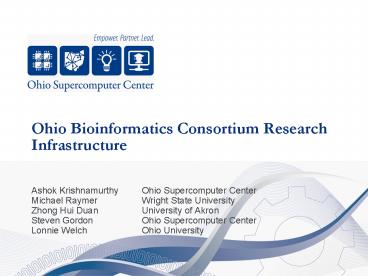Ohio Bioinformatics Consortium Research Infrastructure - PowerPoint PPT Presentation
1 / 14
Title:
Ohio Bioinformatics Consortium Research Infrastructure
Description:
Opteron dual-core w/IBM Cell. 4,000 cores. 8 TBytes memory. 22 teraflops. Blend of 4 core and 8 core nodes. Large processor count. Large memory SMP jobs. Intel ... – PowerPoint PPT presentation
Number of Views:59
Avg rating:3.0/5.0
Title: Ohio Bioinformatics Consortium Research Infrastructure
1
Ohio Bioinformatics Consortium Research
Infrastructure
- Ashok Krishnamurthy Ohio Supercomputer Center
- Michael Raymer Wright State University
- Zhong Hui Duan University of Akron
- Steven Gordon Ohio Supercomputer Center
- Lonnie Welch Ohio University
2
(No Transcript)
3
What is the role of the Research Infrastructure
Group?
- Premise A vibrant research program is essential
to drive world-class education - Goals
- Facilitate interactions
- Identify academic and industry researchers in
Ohio - Create a website to highlight all known research
expertise within the State - Identify research opportunities for students to
be supported by undergraduate and graduate
scholarships. - Assist in seeking external funding for education
e.g., NSF Research Experience for Undergraduate
(REU) and Integrative Graduate Education and
Research Traineeship (IGERT) - Support inter-institutional summer research
opportunities and collaborative projects such as
intra- and inter-collegial competitions.
4
Ohio Bioinformatics Consortium members
5
Ohio Bioinformatics Consortium research expertise
- Genome annotation, Comparative genomics, Pathway
reconstruction, RNA 3D structure, Genetic
variation analysis, Network and systems biology,
Statistical and functional genomics,
Metabolomics, Biomedical ontologies and image
analysis, DNA sequencing, Ribotyping, Microarray
expression analysis, Genome annotation and
databases, Signal recognition and modeling,
Computational biology, Molecular Evolution,
Proteomics and Metabolomics, Structural genomics,
Gene and medical ontologies, Computational
genomics, Regulatory genomics, Proteomics and
Disease research, Functional and regulatory
genomics, Proteomics, Disease research, Plant
genomics, Medical information/ cancer biology,
Proteomics, Comparative genomics, Computational
biology, Medical informatics/ molecular
cardiology, Evolutionary genetics, Medical
informatics, Proteomics, Computational biology,
Marine biology, Environmental science, Health
information/ image processing, Metabolomics,
Biomarker identification/feature selection,
Protein structure, Molecular evolution, Forensic
DNA
6
Stable computational infrastructure to support
the research and innovation process
PRODUCTION COMPUTING
- Itanium2 Cluster
- 2.7 TF
- 596 processors 3x16 Alt
- 1 TBytes memory
- Intel P4 Cluster
- 2.46 TF
- 512 processors
- 1 TBytes memory
Gateway to User Science
Infiniband or Myrinet Interconnect
- IBM 1350
- Opteron dual-core w/IBM Cell
- 4,000 cores
- 8 TBytes memory
- 22 teraflops
- Blend of 4 core and 8 core nodes
- Large processor count
- Large memory SMP jobs
Mass Storage 470 TBytes disk 80 TBytes tape NFS,
PVFS, iSCSI
7
Providing agile computational infrastructure to
support the research and innovation process
RESEARCH COMPUTING
- Visualization Cluster
- AMD Opteron
- 72 processors
- 144 GBytes memory
- nVIDIA Quadro 5600 graphics card(330 GF)
Gateway to User Science
- BALE Cluster
- AMD Athlon 64
- 110 processors
- 220 GBytes memory
- nVIDIA GeForce 6150 GPU
- Cell Blades
- 4 cell blade array
- Accessible from
- IBM e1350
Mass Storage 470 TBytes disk 80 TBytes tape NFS,
PVFS, iSCSI
- MATLAB/GRI Cluster
- AMD Opteron
- 164 processors
- 328 GBytes memory
8
OSC supports a variety of software applications
for scientific research
Top 5 Software Applications by CPU Hours
- Center staff maintain more than 30 software
applications, and we provide access to more than
70 different software packages
Top 5 Software Applications by Projects
9
OSC CI Mission
- OSC Cyberinfrastructure (CI) Mission
- Participating in national CI initiatives (e.g.,
TeraGrid) - Hosting CI applications (e.g., GridChem)
- Developing CI Applications
- CI Software Development (CSD) Group created in
July 2007 - Vision Connect people to supercomputing
applications, large data sets, research
instruments, and virtual communities
10
OSC Cyberinfrastructure Applications
- Web portal applications
- Web-based access to cycles, data, software,
expertise - Basis for OSC collaborations (E-Weld, GRIDP)
- Enable research teams to create and plug in their
own portal - Instrumentation and Analytics Services
- Web-based access to instruments, data sets and
image processing - MATLAB as analytics engine for rapid prototyping
- Basis for OSC collaborations (CAMM, MU NMR)
11
Example 1 GRI Discovery Platform (GRIDP)
- Collaboration between OSC, the University of
Cincinnati's Genome Research Institute (GRI) and
the Ralph Regula School of Computational Science
(RRSCS) - Designed to reduce the technical hurdles
associated with modern computational drug
discovery with an intuitive web-based user
interface to the software - High performance computing (HPC) computational
biology programs are made available as web
services
12
OSC Instrumentation and Analytics Services
- Remote instrumentation uses OSCs state-wide
resources - Networking, Storage, HPC, Analytics (web service)
13
Remote Instrumentation and Analytics with Miami
University
Brucker 850 Mhz NMR in Dr. Kennedys Miami Univ.
lab
- Remote Instrumentation Projects
- NMR Spectrometer, Chemistry and Biochemistry
Dept. - Development of software for remote observation
operation and for storage, retrieval and analysis
of NMR data. (under development, funded by OBR) - Unipulsed EPR Spectrometer, Chemistry and
Biochemistry Dept. - Development of software for remote operations
and/or observation - High Resolution TEM, Electron Microscopy Facility
(EMF), Geography Dept. - Development of software for remote operations
and/or observation - Biomarker discovery engine
- Development of a web-portal for data hosting and
analytics in support of biomarker-based
diagnostic testing research (Frantz Biomarkers
and MU, ODOD BRCP Proposal, pending)
Joel TEM in the EM Facility at Miami Univ.
13
14
MATLAB Distributed Computing Toolbox Architecture
Image source http//www.mathworks.com
15
Common software services































